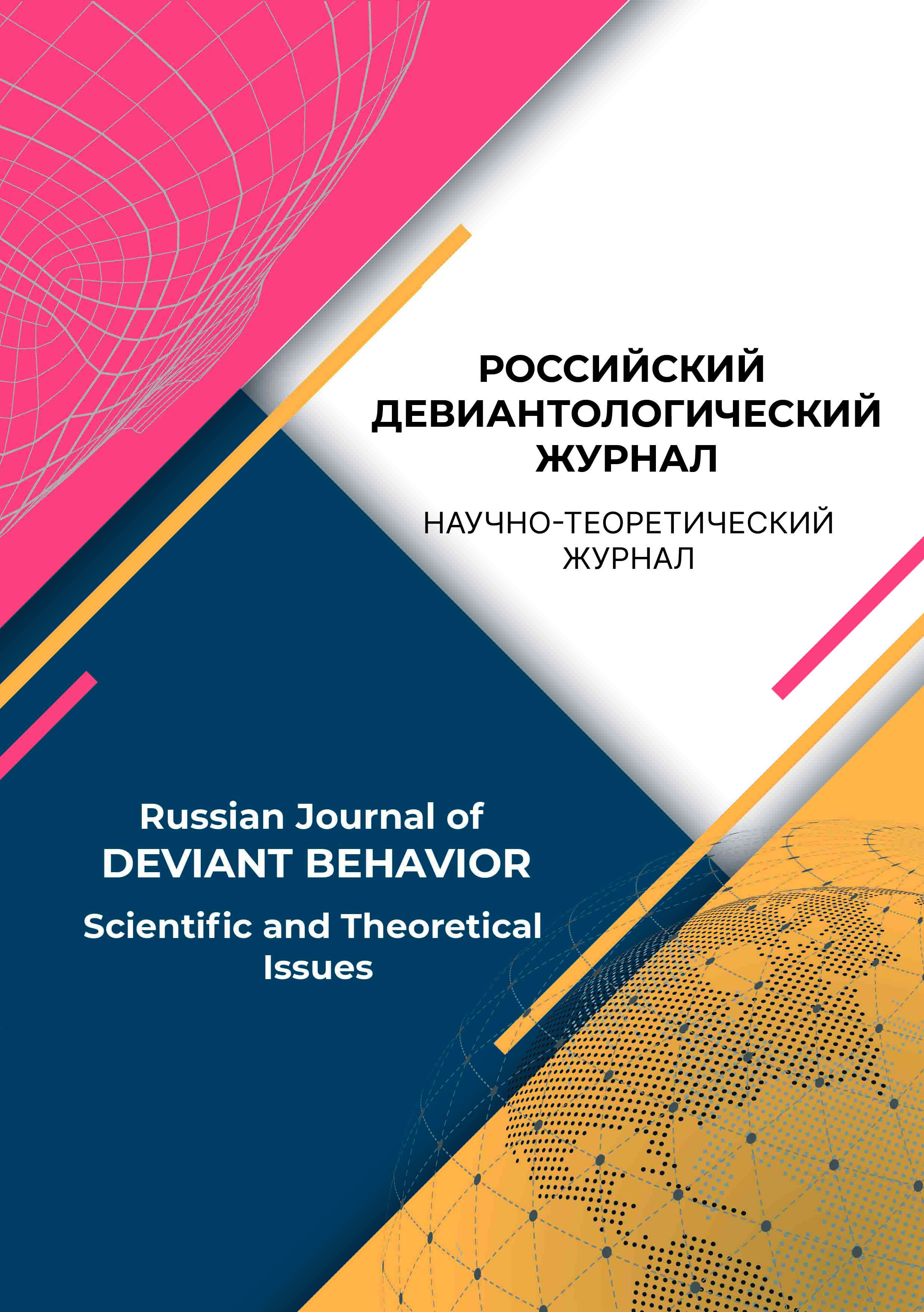Russian Federation
employee from 01.01.2018 until now
Lyubercy, Moscow, Russian Federation
This article deals with the problem of early diagnosis of the use of psychoactive substances in the child and adolescent environment, as well as the study of individual and personal characteristics of individuals at addictive risk. On the basis of the conducted research, the authors carried out a factor analysis of the personal characteristics of individuals of the addictive risk group, based on the use of the psychodiagnostic questionnaire PDO «Narcorisk» (Syrkin et al., 2016) together with a teenage version of the 16-factor Ketell questionnaire and a standardized multifactor method modified for adolescents personality studies (SMIL L. Sobchik). It is assumed that there are correlations between the risk profiles of persons prone to the use of psychoactive substances and their individual and personal characteristics, consideration of which makes it possible to personalize preventive work. The authors note that the factor analysis of the obtained results makes it possible to identify characteristic features of the studied personality profiles. Thus, the abusive personality profile is characterized by: openness, subordination, credulity, conformity, pessimism and anxiety, as well as disorganization and lack of individuality. The hedonistic personality profile correlated with such indicators as openness, emotional stability, courage, tension, impulsivity, individuality, optimism, impracticality and insubordination. The antisocial personality profile is characterized by emotional instability, insubordination, intemperance, rigidity, straightforwardness, anxiety, tension, low self-control, impulsivity, rigidity and social introversion. The conformal personality profile is characterized by: subordination, credulity, practicality, anxiety, conservatism, conformity, self-control, tension, neurotic overcontrol, pessimism and rigidity. The cognitive-destructive personality profile is represented by such characteristics as: reduced intelligence, subordination, conformity and rigidity. The results obtained allow practitioners in the field of psychology and pedagogy of dependent behavior to better understand the nature of the formation of the risk profile of adolescents prone to the use of psychoactive substances, provide them with targeted preventive care, develop and adjust the content of preventive measures, predict behavioral strategies, build an individual preventive route taking into account their individual and personal characteristics.
addictive behavior, addictive risk group, factor analysis, personality characteristics, personification of preventive work
1. Belousova, A. K., Nikolaeva, A. Yu., Evseeva, O. E. (2014). Kognitivnaya sfera narkotirovannoy lichnosti v yunosheskom vozraste. Prikladnaya yuridicheskaya psihologiya, 2, 37-47.
2. Bubeev, Yu. A., Kozlov, V. V., Nikiforov, I. F. (2006). Integrativnye psihotehnologii v profilaktike i korrekcii zavisimogo povedeniya: monografiya. Firma «Slovo».
3. Vagner, E. F., Uoldron, H. B. (2006). Alkogol'naya i narkoticheskaya zavisimost' u podrostkov. Puti preodoleniya: uchebnoe posobie (per. A.V. Aleksandrova, V.M. Yaltonskiy). Akademiya.
4. Iutin, V. M., Syrkin, L. D., Faruh, A. A. (2004). Puti povysheniya effektivnosti diagnostiki i ekspertizy zloupotrebleniy narkoticheskimi sredstvami. Voenno-medicinskiy zhurnal, 7(325), 44-48.
5. Korolenko, C. P., Dmitrieva, N. V. (2001). Psihosocial'naya addiktologiya. Novosibirsk: «Olsib».
6. Korchagina, G. A., Fadeeva, E. V. (2015). Ocenka effektivnosti programm profilaktiki potrebleniya psihoaktivnyh veschestv. Medicinskaya psihologiya v Rossii, 2(31).
7. Sirota, N. A., Yaltonskiy, V. M. (2004). Effektivnye programmy profilaktiki zavisimosti ot narkotikov i drugih form zavisimogo povedeniya. Moskva: OOO Centr poligraficheskih uslug «Raduga».
8. Sirota, N. A., Zuykova, A. A., Safronov, A. I., Zolotoreva, L. I., (2020). Primenenie metodov sub'ektivnoy semantiki v reshenii zadach profilaktiki upotrebleniya PAV licami gruppy addiktivnogo riska. Chelovecheskiy kapital, 9(141), 244-250. doi:https://doi.org/10.25629/HC.2020.09.22
9. Syrkin, L. D., Lyapin, A. S., Safronov, A. I., Zuykova, A. A., (2015). Metodicheskie podhody k probleme monitoringa i rannego vyyavleniya riskov formirovaniya zavisimogo povedeniya v molodezhnoy srede. Vestnik vosstanovitel'noy mediciny, 3(67).
10. Syrkin, L. D., Lyapin, A. S., Zuykova, A. A., Safronov, A. I. (2016). Ispol'zovanie metodiki «Psihodiagno-sticheskiy oprosnik «Narkorisk» v social'no-psihologicheskom testirovanii v obrazovatel'nyh organizaciyah. Nauchnyy internet-zhurnal «Mir nauki», 1(4).
11. Taşören, A. B. (2017). Drug Use and Self-Harming Behavior Among Incarcerated Men: Does Childhood Abuse, Anger, and Executive Function Make a Difference? Journal of Aggression, Maltreatment & Trauma, 26(9), 1006-1023. https://doi.org/10.1080/10926771.2017.1346028
12. Dong, B., & Krohn, M. D. (2020). Sent Home Versus Being Arrested: The Relative Influence of School and Police Intervention on Drug Use. Justice Quarterly, 37(6), 985-1011. https://doi.org/10.1080/07418825.2018.1561924
13. Kelly, B. C., Harris, E., & Vuolo, M. (2017). Psychosocial Influences of the Escalation of Deviance: The Case of Prescription Drug Sniffing. Deviant Behavior, 38(8), 941-956. https://doi.org/10.1080/01639625.2016.1229934
14. Evans, Caroline B. R., Stalker, K. C., & Brown, M. E. (2021). A systematic review of crime/violence and substance use prevention programs. Aggression and Violent Behavior, Volume 56, January-February 2021, 101513. https://doi.org/10.1016/j.avb.2020.101513
15. Kroner, D. G., Morrison, M. M., & Lowder, E. M. (2020). A Principled Approach to the Construction of Risk Assessment Categories: The Council of State Governments Justice Center Five-Level System. International Journal of Offender Therapy and Comparative Criminology, 64(10-11), 1074-1090. https://doi.org/10.1177/0306624X19870374
16. Fernández-Montalvo, J, López-Goñi, J. J., & Arteaga, A. (2012). Violent Behaviors in Drug Addiction: Differential Profiles of Drug-Addicted Patients With and Without Violence Problems. Journal of Interpersonal Violence, 27(1), 142-157. https://doi.org/10.1177/0886260511416475
17. Gibbs, B. R., Lytle, R, & Wakefield, W. (2019). Outcome Effects on Recidivism Among Drug Court Participants. Criminal Justice and Behavior, 46(1), 115-135. https://doi.org/10.1177/0093854818800528
18. Cao, H., Liang, Y., Li, X., Zhu, L., Wu, L., Liu, H., Jiang, L., Zhou, N., & Zhang, J. (2021). Childhood Maltreatment and Affective Symptoms and Severity of Drug Addiction among Chinese Male Drug Users: Variable-Centered and Person-Centered Approaches. Journal of Aggression, Maltreatment & Trauma, 30(8), 1007-1027. https://doi.org/10.1080/10926771.2020.1796874
19. Erickson, J. H. (2021). “Wild in My Eyes”: An Analysis of Narratives and Narrative Identities among Diverse Drug Users. Deviant Behavior. https://doi.org/10.1080/01639625.2021.1990740
20. Phillippi, S. W., Thomas, C. L., & Lentini, K. (2021). Translation of National Juvenile Drug Treatment Court Guidelines into Statewide Standards and Practices: a Case Study. Am J Crim Just, 46, 483-495. https://doi.org/10.1007/s12103-020-09563-z















